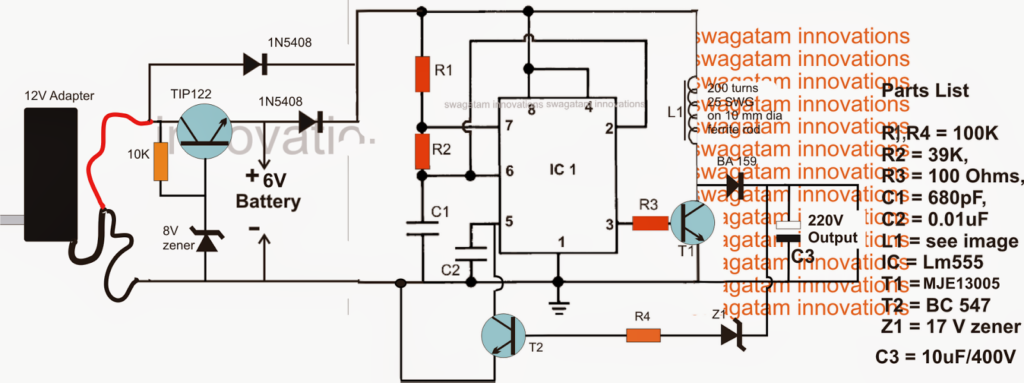The article clarifies an easy boost converter UPS circuit for offering an uninterruptible power to satellite TV set top boxes in order that the offline recording can never be in a position to fail all through power outages.
I had looked at a small back up system,
I had obtained a small 6 volt 11 watt CFL Ballast circuit believing as low-cost alternate solution, but the same failed to work.
Why I am looking for AC supply rather then DC?
I do not desire to tamper with their system and get penalized for what ever downfalls that might come across it on account of natural span of process.
Could you please guide me with an uncomplicated affordable circuit which may offer me 220 volt 20 watts power from 6 volt 5ah battery. To be specific 220 volts from 6 volt battery, as I have obtained a 6 volt 5 ah battery recently. The output wattage need is lesser than 20 watts, the adapter ratings are:
Output - 16 volt 1 amp
Input - 240 volt.06 amp
The Design
6V to 220V Boost UPS Circuit for Satellite TV Modems
Due to the fact nowadays all electronic systems work with an SMPS power supply, the input is unable necessarily needs to be an AC for generating these kinds of equipment, relatively an equivalent DC or pulsed DC also develop into beneficial and performs pretty much as good.
Making reference to the diagram above, a number of segments can be viewed, the IC1 setting makes it possible for a 6V DC to be enhanced to a more significant 220V pulsed DC by way of a boost converter topology making use of the IC 555 in its astable form. The extreme left side battery section confirms an changeover from mains to battery back up every time a power failure is imagined by the circuit.
The thought is quite effortless and is not going to need to have much of an elaboration.
IC1 is designed as an astable oscillator, which drives T1 as well as L1 at the same frequency.
T1 causes the complete battery current across L1, triggering a relatively boosted voltage to turn up across it in the course of the OFF periods of the T1 (induced back EMF from L1).
L1 ought to be correctly determined such that it yields the preferred magnitude of voltage across the presented terminals.
The suggested 200 turns is tentatively worked out and may require considerably tweaking for acquiring the proposed 220V from the input 6V battery source.
T2 is presented for regulating the output voltage to the required safe levels, which is 220V here.
Z1 needs to be as a result a 220V zener, which carries out as soon as this limit is went beyond, which leads T2 to carry out and ground pin5 of the IC, stalling the frequency at pin3 to a zero voltage.
The above method continue to readjusts itself swiftly providing an ongoing 220V at the output.
The adapter which may be noticed at the extreme left is commonly employed for two purposes, first making sure that IC1 performs constantly and delivers the essential 220V for the associated load no matter what the mains existence (equally as we now have in online UPS systems), so you can make certain a charging current for the battery when mains voltage occurs.
The relevant TIP122 transistor is situated to create a controlled 7V DC for the battery in order to reduce over charging of the battery.
